Abstract
The ability of 22 Edwardsiella strains to penetrate and replicate in cultured epithelial cells was initially evaluated by light microscopy methods and by the recovery of gentamicin-resistant (Gmr) bacteria from the Triton X-100 cell lysates of HEp-2-infected monolayers. Giemsa-stained HEp-2 cells revealed the presence of numerous internalized bacteria 3 h postinfection, often appearing as parallel rows of replicated bacteria within the cytosol and sometimes obliterating the cytoplasm because of the large numbers of bacilli present. Invasive bacteria were also sometimes found within cytoplasmic vacuoles in infected cells; thin-section electron micrographs of HEp-2-infected cells supported these conclusions. Results of light microscopy studies and cell lysate assays indicated that most Edwardsiella tarda (92%) and some Edwardsiella hoshinae strains were invasion positive on one or more occasions, while Edwardsiella ictaluri isolates were uniformly negative. HEp-2 invasion by E. tarda was a microfilament-dependent (cytochalasin B- and D-sensitive) process, with maximum numbers of Gmr CFU recorded between 3 and 6 h postinfection. The small percentage (0.01 to 1.0%) of the challenge inoculum recoverable as Gmr progeny 3 to 6 h postinfection was attributed to a strong cell-associated (not filterable) hemolysin that was produced by a majority (85%) of the E. tarda strains but not by E. ictaluri and only minimally by E. hoshinae. This cytolysin/hemolysin was responsible for the toxic effects observed in HEp-2 cells during the infection-replication process of edwardsiellae and appears to play a role in the release of internalized and replicated bacteria from infected cells. The results suggest an invasion strategy with some similarities to and differences from those of other recognized enteroinvasive pathogens.
Full text
PDF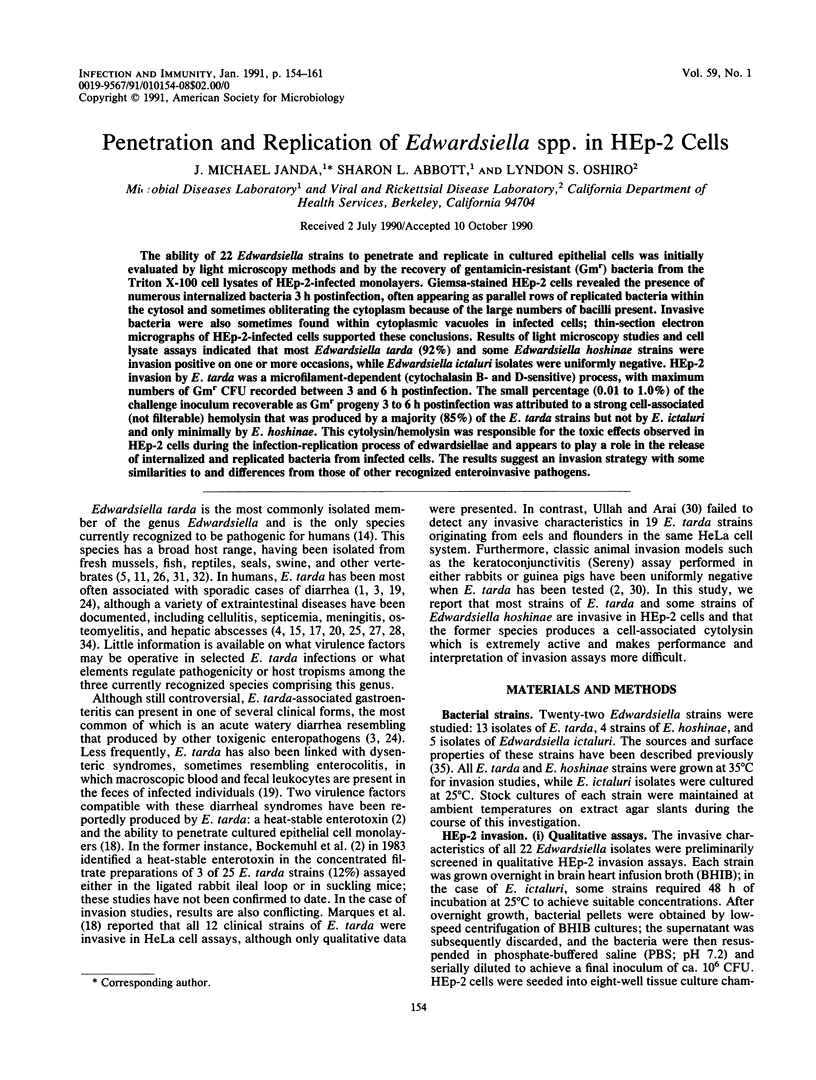
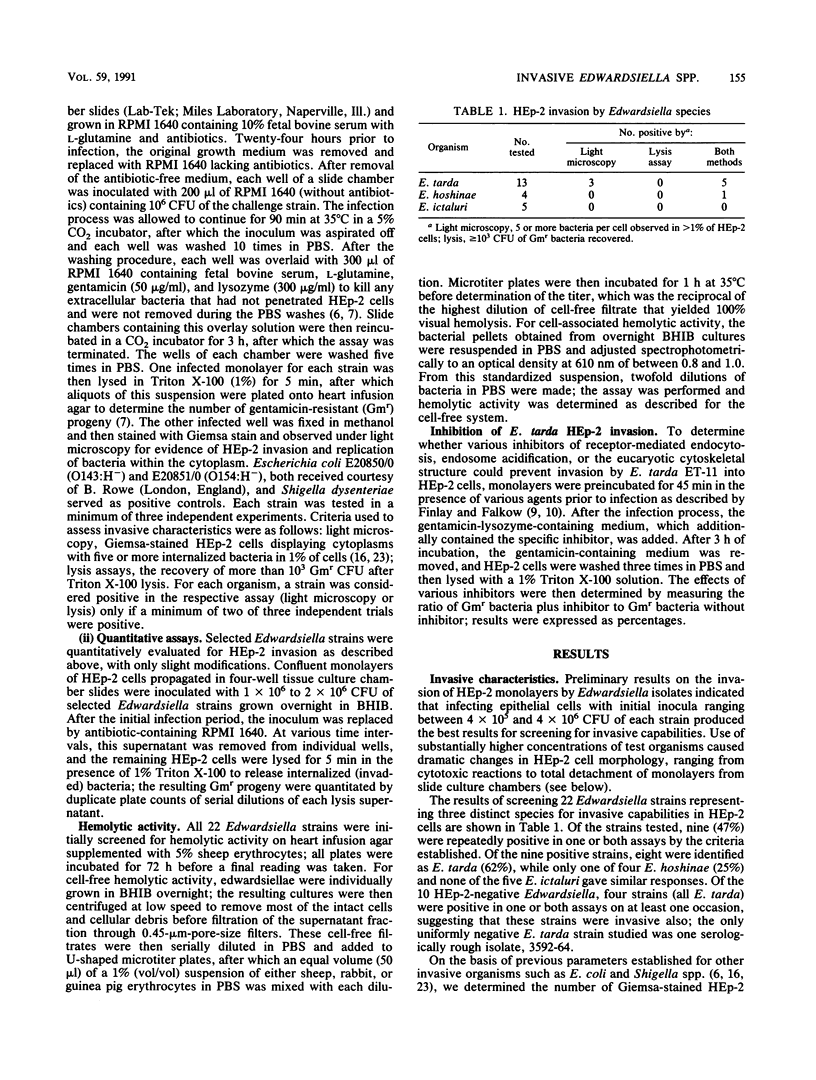

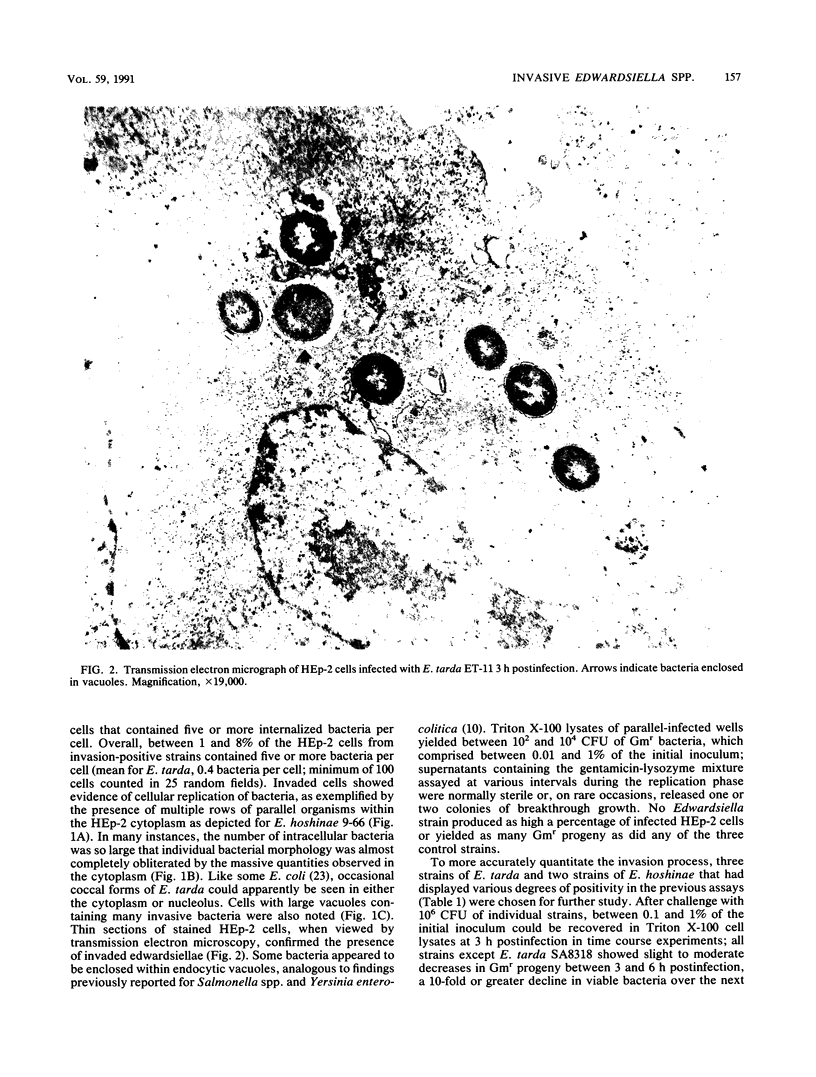
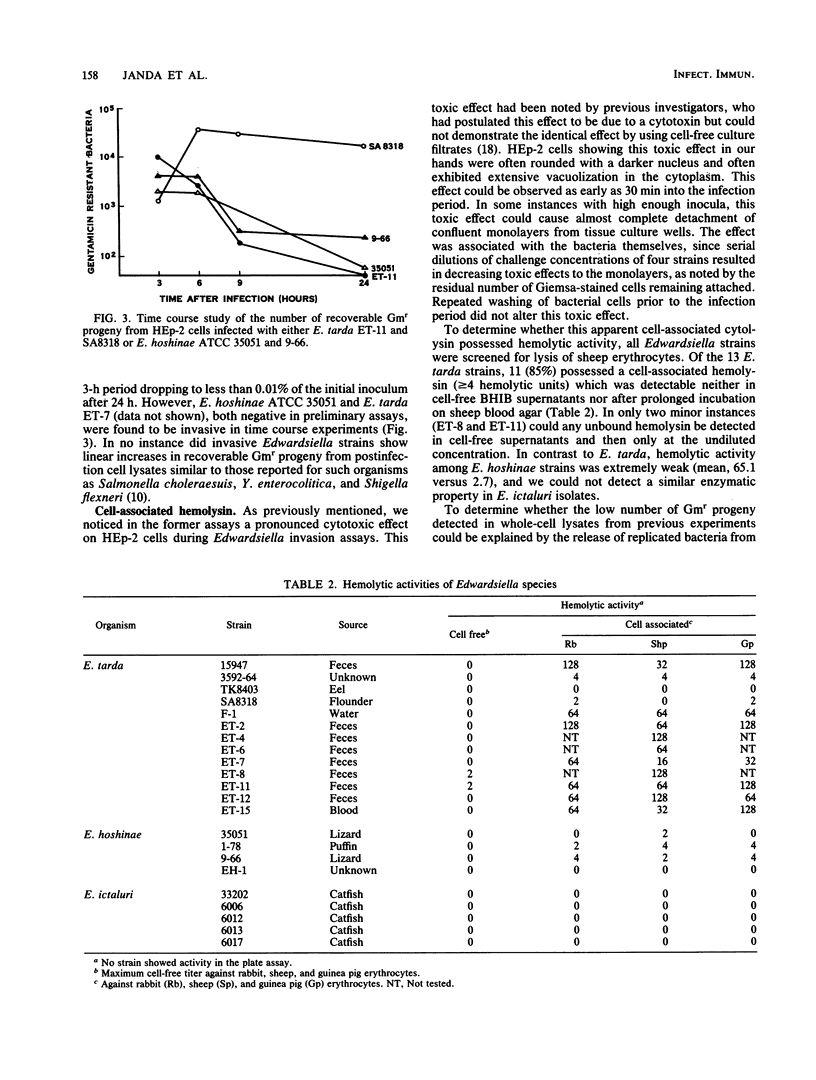
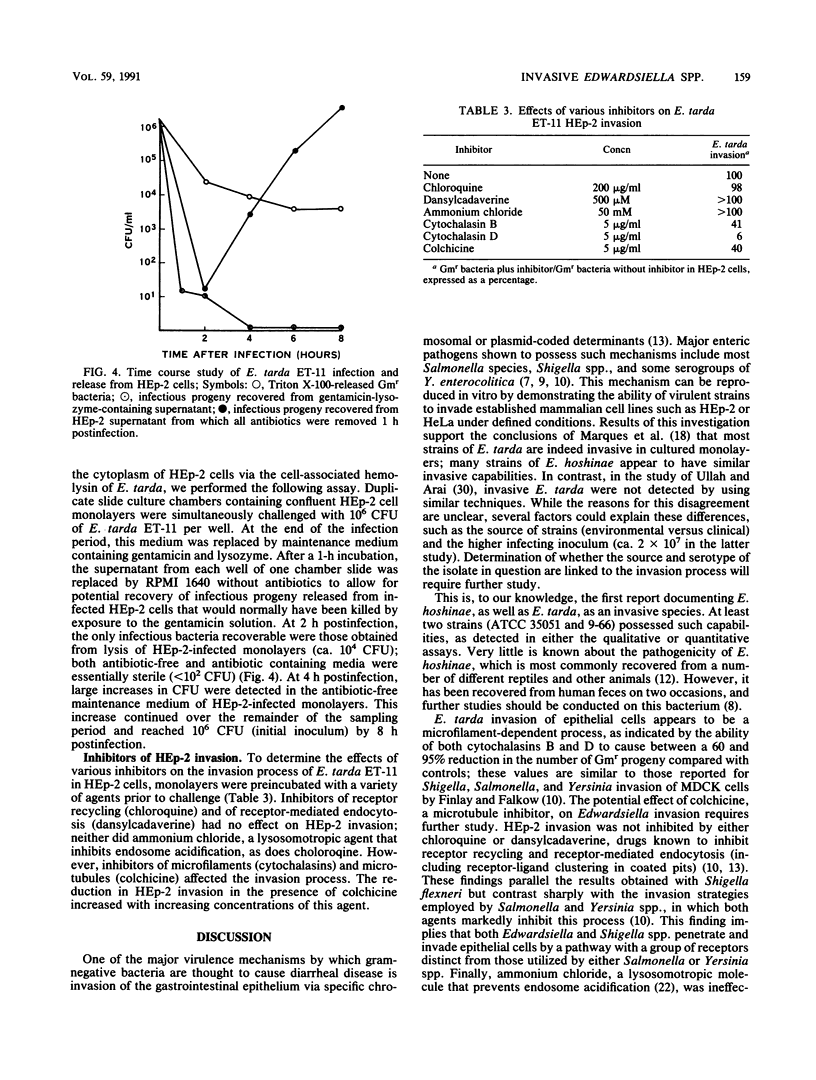

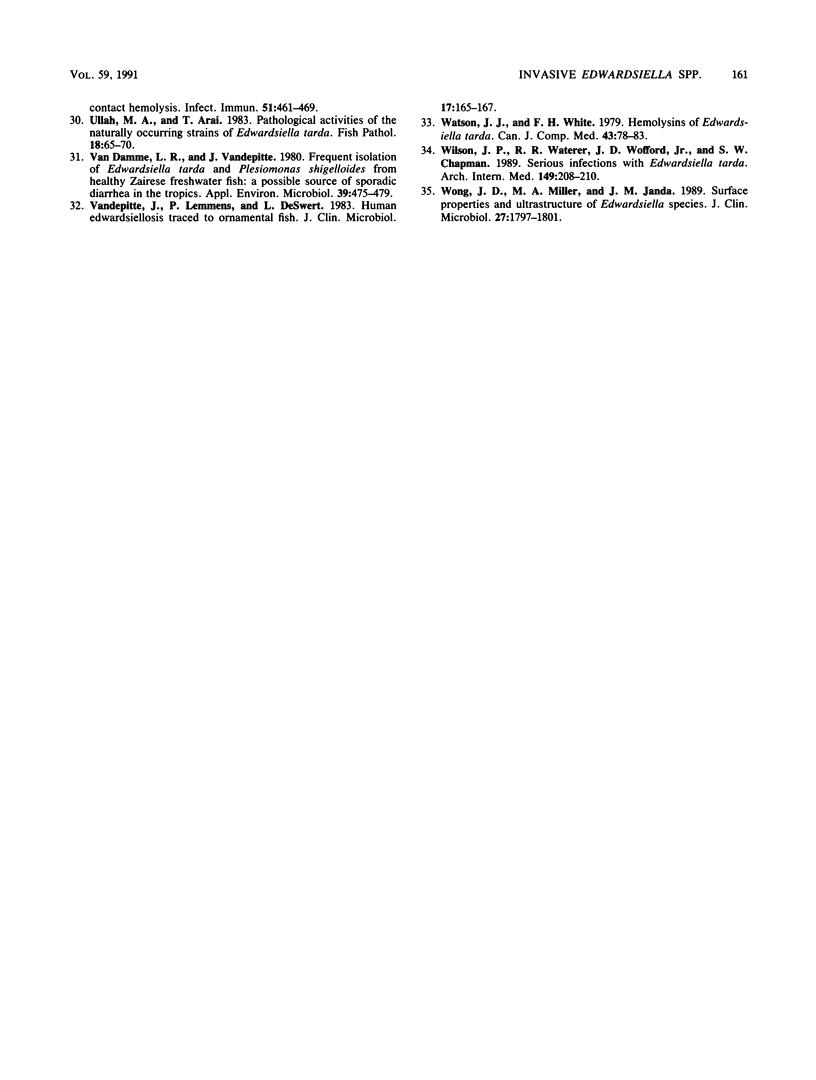
Images in this article
Selected References
These references are in PubMed. This may not be the complete list of references from this article.
- Bhat P., Myers R. M., Carpenter K. P. Edwardsiella tarda in a study of juvenile diarrhoea. J Hyg (Lond) 1967 Sep;65(3):293–298. doi: 10.1017/s0022172400045812. [DOI] [PMC free article] [PubMed] [Google Scholar]
- Bockemühl J., Aleksic V., Wokatsch R., Aleksic S. Pathogenicity tests with strains of Edwardsiella tarda: detection of a heat-stable enterotoxin. Zentralbl Bakteriol Mikrobiol Hyg A. 1983 Nov;255(4):464–471. [PubMed] [Google Scholar]
- Bockemühl J., Pan-Urai R., Burkhardt F. Edwardsiella tarda associated with human disease. Pathol Microbiol (Basel) 1971;37(5):393–401. [PubMed] [Google Scholar]
- Clarridge J. E., Musher D. M., Fainstein V., Wallace R. J., Jr Extraintestinal human infection caused by Edwardsiella tarda. J Clin Microbiol. 1980 May;11(5):511–514. doi: 10.1128/jcm.11.5.511-514.1980. [DOI] [PMC free article] [PubMed] [Google Scholar]
- Cook R. A., Tappe J. P. Chronic enteritis associated with Edwardsiella tarda infection in Rockhopper penguins. J Am Vet Med Assoc. 1985 Dec 1;187(11):1219–1220. [PubMed] [Google Scholar]
- Day N. P., Scotland S. M., Rowe B. Comparison of an HEp-2 tissue culture test with the Serény test for detection of enteroinvasiveness in Shigella spp. and Escherichia coli. J Clin Microbiol. 1981 Mar;13(3):596–597. doi: 10.1128/jcm.13.3.596-597.1981. [DOI] [PMC free article] [PubMed] [Google Scholar]
- Falkow S., Small P., Isberg R., Hayes S. F., Corwin D. A molecular strategy for the study of bacterial invasion. Rev Infect Dis. 1987 Sep-Oct;9 (Suppl 5):S450–S455. doi: 10.1093/clinids/9.supplement_5.s450. [DOI] [PubMed] [Google Scholar]
- Finlay B. B., Falkow S. Comparison of the invasion strategies used by Salmonella cholerae-suis, Shigella flexneri and Yersinia enterocolitica to enter cultured animal cells: endosome acidification is not required for bacterial invasion or intracellular replication. Biochimie. 1988 Aug;70(8):1089–1099. doi: 10.1016/0300-9084(88)90271-4. [DOI] [PubMed] [Google Scholar]
- Goldstein E. J., Agyare E. O., Vagvolgyi A. E., Halpern M. Aerobic bacterial oral flora of garter snakes: development of normal flora and pathogenic potential for snakes and humans. J Clin Microbiol. 1981 May;13(5):954–956. doi: 10.1128/jcm.13.5.954-956.1981. [DOI] [PMC free article] [PubMed] [Google Scholar]
- Jordan G. W., Hadley W. K. Human infection with Edwardsiella tarda. Ann Intern Med. 1969 Feb;70(2):283–288. doi: 10.7326/0003-4819-70-2-283. [DOI] [PubMed] [Google Scholar]
- Koshi G., Lalitha M. K. Edwardsiella tarda in a variety of human infections. Indian J Med Res. 1976 Dec;64(12):1753–1759. [PubMed] [Google Scholar]
- Labrec E. H., Schneider H., Magnani T. J., Formal S. B. EPITHELIAL CELL PENETRATION AS AN ESSENTIAL STEP IN THE PATHOGENESIS OF BACILLARY DYSENTERY. J Bacteriol. 1964 Nov;88(5):1503–1518. doi: 10.1128/jb.88.5.1503-1518.1964. [DOI] [PMC free article] [PubMed] [Google Scholar]
- Le Frock J. L., Klainer A. S., Zuckerman K. Edwardsiella tarda bacteremia. South Med J. 1976 Feb;69(2):188–190. doi: 10.1097/00007611-197602000-00018. [DOI] [PubMed] [Google Scholar]
- Marsh P. K., Gorbach S. L. Invasive enterocolitis caused by Edwardsiella tarda. Gastroenterology. 1982 Feb;82(2):336–338. [PubMed] [Google Scholar]
- Maserati R., Farina C., Valenti L., Filice C. Liver abscess caused by Edwardsiella tarda. Boll Ist Sieroter Milan. 1985;64(5):419–421. [PubMed] [Google Scholar]
- Maurelli A. T. Temperature regulation of virulence genes in pathogenic bacteria: a general strategy for human pathogens? Microb Pathog. 1989 Jul;7(1):1–10. doi: 10.1016/0882-4010(89)90106-x. [DOI] [PubMed] [Google Scholar]
- Mehlman I. J., Eide E. L., Sanders A. C., Fishbein M., Aulisio C. C. Methodology for recognition of invasive potential of Escherichia coli. J Assoc Off Anal Chem. 1977 May;60(3):546–562. [PubMed] [Google Scholar]
- Mellman I., Fuchs R., Helenius A. Acidification of the endocytic and exocytic pathways. Annu Rev Biochem. 1986;55:663–700. doi: 10.1146/annurev.bi.55.070186.003311. [DOI] [PubMed] [Google Scholar]
- Nagel P., Serritella A., Layden T. J. Edwardsiella tarda gastroenteritis associated with a pet turtle. Gastroenterology. 1982 Jun;82(6):1436–1437. [PubMed] [Google Scholar]
- Okubadejo O. A., Alausa K. O. Neonatal meningitis caused by Edwardsiella tarda. Br Med J. 1968 Aug 10;3(5614):357–358. doi: 10.1136/bmj.3.5614.357. [DOI] [PMC free article] [PubMed] [Google Scholar]
- Owens D. R., Nelson S. L., Addison J. B. Isolation of Edwardsiella tarda from swine. Appl Microbiol. 1974 Apr;27(4):703–705. doi: 10.1128/am.27.4.703-705.1974. [DOI] [PMC free article] [PubMed] [Google Scholar]
- Rao K. R., Shah J., Rajashekaraiah K. R., Patel A. R., Miskew D. B., Fennewald P. S. Edwardsiella tarda osteomyelitis in a patient with SC hemoglobinopathy. South Med J. 1981 Mar;74(3):288–292. doi: 10.1097/00007611-198103000-00009. [DOI] [PubMed] [Google Scholar]
- Sachs J. M., Pacin M., Counts G. W. Sickle hemoglobinopathy and Edwardsiella tarda meningitis. Am J Dis Child. 1974 Sep;128(3):387–388. doi: 10.1001/archpedi.1974.02110280117018. [DOI] [PubMed] [Google Scholar]
- Sansonetti P. J., Ryter A., Clerc P., Maurelli A. T., Mounier J. Multiplication of Shigella flexneri within HeLa cells: lysis of the phagocytic vacuole and plasmid-mediated contact hemolysis. Infect Immun. 1986 Feb;51(2):461–469. doi: 10.1128/iai.51.2.461-469.1986. [DOI] [PMC free article] [PubMed] [Google Scholar]
- Van Damme L. R., Vandepitte J. Frequent isolation of Edwardsiella tarda and Pleisiomonas shigelloides from healthy Zairese freshwater fish: a possible source of sporadic diarrhea in the tropics. Appl Environ Microbiol. 1980 Mar;39(3):475–479. doi: 10.1128/aem.39.3.475-479.1980. [DOI] [PMC free article] [PubMed] [Google Scholar]
- Vandepitte J., Lemmens P., de Swert L. Human Edwardsiellosis traced to ornamental fish. J Clin Microbiol. 1983 Jan;17(1):165–167. doi: 10.1128/jcm.17.1.165-167.1983. [DOI] [PMC free article] [PubMed] [Google Scholar]
- Watson J. J., White F. H. Hemolysins of Edwardsiella tarda. Can J Comp Med. 1979 Jan;43(1):78–83. [PMC free article] [PubMed] [Google Scholar]
- Wilson J. P., Waterer R. R., Wofford J. D., Jr, Chapman S. W. Serious infections with Edwardsiella tarda. A case report and review of the literature. Arch Intern Med. 1989 Jan;149(1):208–210. [PubMed] [Google Scholar]
- Wong J. D., Miller M. A., Janda J. M. Surface properties and ultrastructure of Edwardsiella species. J Clin Microbiol. 1989 Aug;27(8):1797–1801. doi: 10.1128/jcm.27.8.1797-1801.1989. [DOI] [PMC free article] [PubMed] [Google Scholar]




